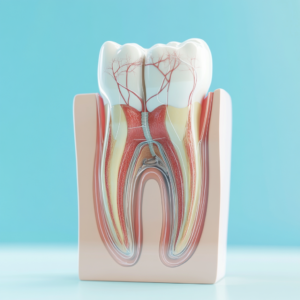How long does IV Dental Sedation last?
How long does IV Dental Sedation last? How long does IV Dental Sedation last? Understanding IV Dental Sedation IV dental sedation has gained popularity as
If you’ve been told you need a root canal, you may feel nervous or confused about what the process involves. This blog will guide you through every step of the procedure so you know what to expect and how it helps save your tooth. Understanding the process can ease your concerns and prepare you for the treatment.
 A root canal is a dental procedure used to save a tooth that’s been damaged or infected. Inside your tooth, beneath the hard enamel and dentin layers, is the pulp, a soft tissue containing nerves, blood vessels, and connective tissue. When the pulp becomes infected, either due to decay or injury, it causes pain and can lead to further complications if untreated.
A root canal is a dental procedure used to save a tooth that’s been damaged or infected. Inside your tooth, beneath the hard enamel and dentin layers, is the pulp, a soft tissue containing nerves, blood vessels, and connective tissue. When the pulp becomes infected, either due to decay or injury, it causes pain and can lead to further complications if untreated.
 Root canals are often necessary when the pulp inside your tooth becomes infected or inflamed. This can happen for several reasons, including:
Root canals are often necessary when the pulp inside your tooth becomes infected or inflamed. This can happen for several reasons, including:
Without treatment, the infection can spread to nearby teeth, gums, or even your jawbone, leading to severe pain or tooth loss.
The root canal procedure typically takes one to two appointments, depending on the complexity of the case. Here’s a step-by-step guide to what happens:
Your dentist or endodontist will apply a local anesthetic to numb the affected tooth and surrounding gums. For patients with dental anxiety, additional sedation may be offered to help you relax during the procedure.
A small hole is drilled into the crown (top) of the tooth to access the infected pulp inside. This opening provides access to the inner canals.
Using tiny dental tools, the dentist carefully removes the pulp, which includes nerves, blood vessels, and any infected tissue. This step eliminates the source of the pain and infection.
After removing the pulp, the dentist cleans the canals thoroughly to eliminate bacteria. The canals are then shaped to prepare them for filling.
The cleaned canals are filled with a rubber-like material called gutta-percha. A temporary filling is placed over the opening to protect the tooth until a permanent crown is fitted.
During a follow-up appointment, the dentist places a custom-made crown over the tooth. This crown restores the tooth’s strength, shape, and appearance.
Recovery from a root canal is usually quick, with most patients returning to normal activities within a day. Mild discomfort or sensitivity may persist for a few days. To help your recovery:
Preventive care is the best way to avoid root canals. Brush your teeth at least twice a day, floss daily, and schedule regular dental checkups to catch cavities early before they reach the pulp.
A root canal may sound intimidating, but it’s a straightforward procedure that relieves pain and saves your tooth. Modern techniques make the process comfortable and effective. If you’re experiencing persistent tooth pain or other symptoms, don’t hesitate to consult your dentist.
Check out a podcast on “
How long does IV Dental Sedation last? How long does IV Dental Sedation last? Understanding IV Dental Sedation IV dental sedation has gained popularity as
Are family dentists cheaper? Are family dentists cheaper? Understanding Family Dentists Family dentists play a crucial role in oral health by providing comprehensive dental care
What counts as an emergency dental? Understanding Emergency Dental Situations Dental emergencies can occur at any moment, often leading to significant pain and anxiety for
Will they pull a tooth emergency dentist? Understanding Emergency Dentistry When dental emergencies arise, knowing where to turn is critical for your health and comfort.
How do you know if the dentist you found is a good dentist or not? Choosing a dentist can be a daunting task, especially when
What dental services do Rock Hill dentists offer? Understanding the range of dental services offered by local dentists is vital for maintaining optimal oral health.